Introduction

If you use other people’s content in your assessments without acknowledging them by referencing, it is a form of plagiarism.
There are many different referencing styles, each with its own set of rules. For Open Polytechnic assessments use the American Psychological Association 7th edition referencing style. This is commonly known as APA 7.
Watch this video to get an overview of what referencing is [2 mins]:
Why do I need to reference?
- to show where you found the information you used
- to give credit to the original author/creator
- to give evidence to support points you make in your assessments
- to avoid plagiarism.
If you are new to the concept of plagiarism, it is important you understand what it is and how to avoid it. See Plagiarism for more information.
Remember - You must reference ANY words, ideas, images or information taken from ANY source that you have used in your assessment.
Tip – Assessment marks may be awarded for referencing so be sure to check.
When do I need to reference?
Referencing is a formal way of showing when you have used information from other sources in your assessment, whether from a book, article, website, or somewhere else.
You must reference any source you refer to in your assessment, i.e. ANY words, ideas, facts, theories, images or information taken from ANY source requires a reference. This includes:
- books
- articles
- reports
- webpages
- images
- videos
- data, tables, graphs...
You don’t need to reference when using:
- your own ideas (unless you included them in an earlier assessment)
- common knowledge – this means something that lots of people will know, or information that can be easily found in many sources,
e.g. The Covid-19 virus was discovered in 2019.
See more: What Is Common Knowledge? - Scribbr.
Referencing is necessary whether you have directly quoted (copied the exact words) or paraphrased the original text into your own words (see How do I quote or paraphrase).
|
Note, including information from other sources is only part of writing an assessment. It is important that much of the writing is your own words. Other sources are generally used to:
|
What is plagiarism?
Plagiarism is when you use someone else's work and present it as your own, even if you do it unintentionally. It includes:
- not acknowledging sources
- copying the work of another learner
- copying from texts, online resources or other works without correct citation.
It also includes reusing your own writing from another assessment without acknowledging this.
If you are found to be plagiarising, you could be accused of academic misconduct. For more information visit the Open Polytechnic page on Academic Integrity.
Plagiarism checkers
Assessments submitted at Open Polytechnic pass through a plagiarism checker called Turnitin. Turnitin provides a plagiarism score to your marker. This is why it's essential that your assessment is your own work and that you have clearly shown where you have referred to other sources.
Can I use a plagiarism checker myself?
You might like to try one of the checkers below. However:
- keep in mind that plagiarism checkers are not guaranteed to pick up everything
- make sure the tool is not rewriting your content
- check out Using grammar and writing assistants in assessments
Grammarly Plagiarism Checker
Grammarly has a free plagiarism checker (more features can also be unlocked if you upgrade to a paid subscription):
https://www.grammarly.com/plagiarism-checker
Quilbot is also a good tool and has a plagiarism checker with a paid subscription:
https://quillbot.com/plagiarism-checker?referrer=side_navbar
What the Open Polytechnic does about plagiarism
The Open Polytechnic regards plagiarism as cheating. We use similarity detection software to identify plagiarised work.
Learner misconduct involves any form of unacceptable or improper behaviour by learners, including misconduct during assessment (cheating).
Learners who assist or encourage another person to act in a manner that constitutes misconduct are dealt with as if they had committed misconduct themselves.
Learners suspected of academic misconduct are informed and the process is followed as stated in the Academic Statue section 13.
You can find the Academic Statute here
If you are found guilty of plagiarism, you will lose marks and could incur even more severe penalties. You could also be penalised if you allow another learner to copy from you.
See our Academic integrity page to learn more about being honest, respectful and ethical in your study and assessments.
How do I reference?
(Also check out our video at the bottom of this page).
You must reference ANY words, ideas, images or information taken from ANY source that you have used in your assessment.
APA referencing involves two essential parts:
- in-text citations
- References list
In-text citations
In-text citations sit in your text along with the information you have used.
You need to include an in-text citation each time you refer to information from somewhere else.
Do this if you are directly quoting (taking the exact words from a source) or paraphrasing (re-wording the information into your own words).
In-text citations link to full references on a references list. The references list goes at the end of your assessment.
Here's an example of in-text citations linking to a references list:
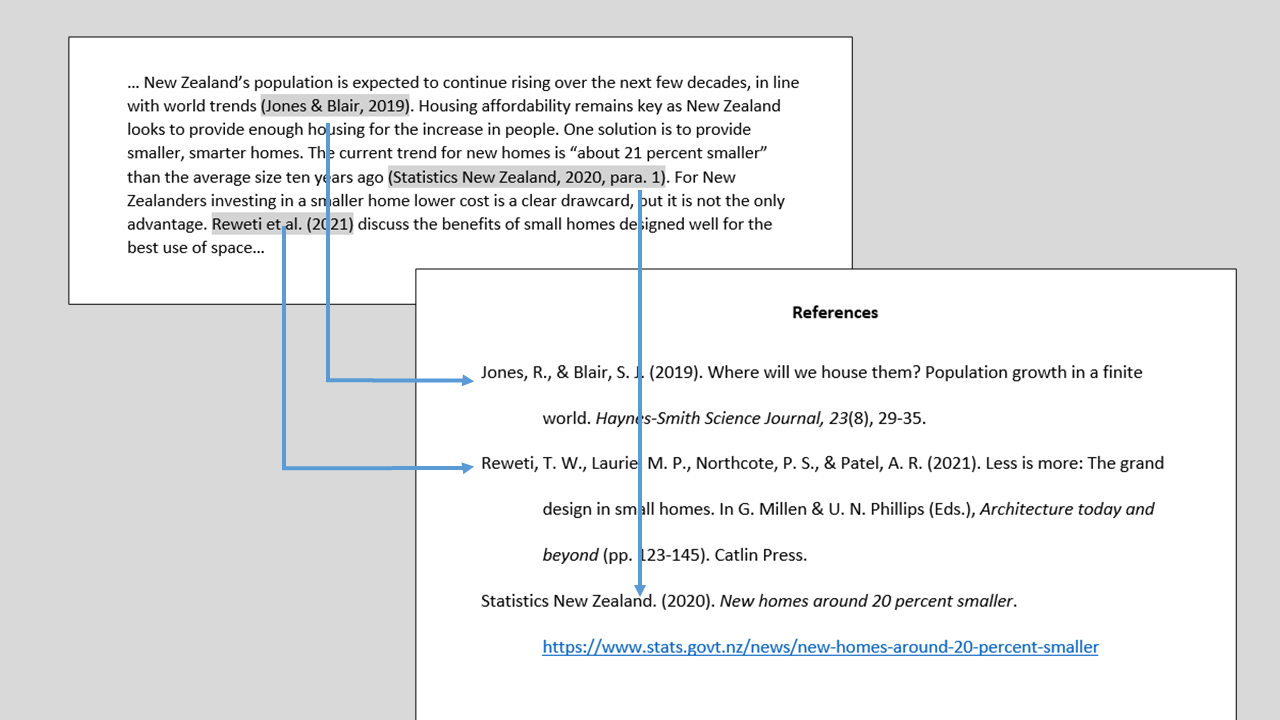
Format of in-text citations
In-text citations usually include author and year the work was published.
Direct quotes must also include a page number (or paragraph number if there are no pages, like on a webpage) and the quote must be in double quotation marks.
Examples of in-text citations
Below, the in-text citations are shown in red (but would normally be black).
Paraphrase (from a book)
To extinguish a large fire by helicopter is a highly demanding undertaking, but very rewarding if you succeed (Reid, 2014).
or
Reid (2014) says to extinguish a large fire by helicopter is a highly demanding undertaking, but very rewarding if you succeed.
In the second example above, you'll notice the author has already been mentioned as part of the sentence. In that case, only the date needs to be included in brackets.
(Note, the above is demonstrating how to cite a single author. See APA guides, for examples of citing two or more).
Short direct quote (from a webpage)
“You need to be able to think clearly under pressure, to apply common sense amidst the action, be emotionally resilient, and exhibit courage when the going gets tough” (Fire and Emergency New Zealand, 2023, para. 5).
In the above example, the author is an organisation, rather than an individual.
Notice the double quotation marks around the words in the quote above. These are important when you are using the original author’s exact words.
See How do I quote or paraphrase? for more information, including how to format long quotes.
References list
The references list sits at the end of your assessment.
It’s a list of all the sources you’ve mentioned in your writing.
List each source once, even if you have referred to that source more than once within your text.
The sources are listed alphabetically, by author. The list is also double spaced and uses hanging indent. See this guide for how to apply spacing, hanging indent and A-Z ordering:
Here is an example references list (can you spot the full references for our two in-text citations above?):
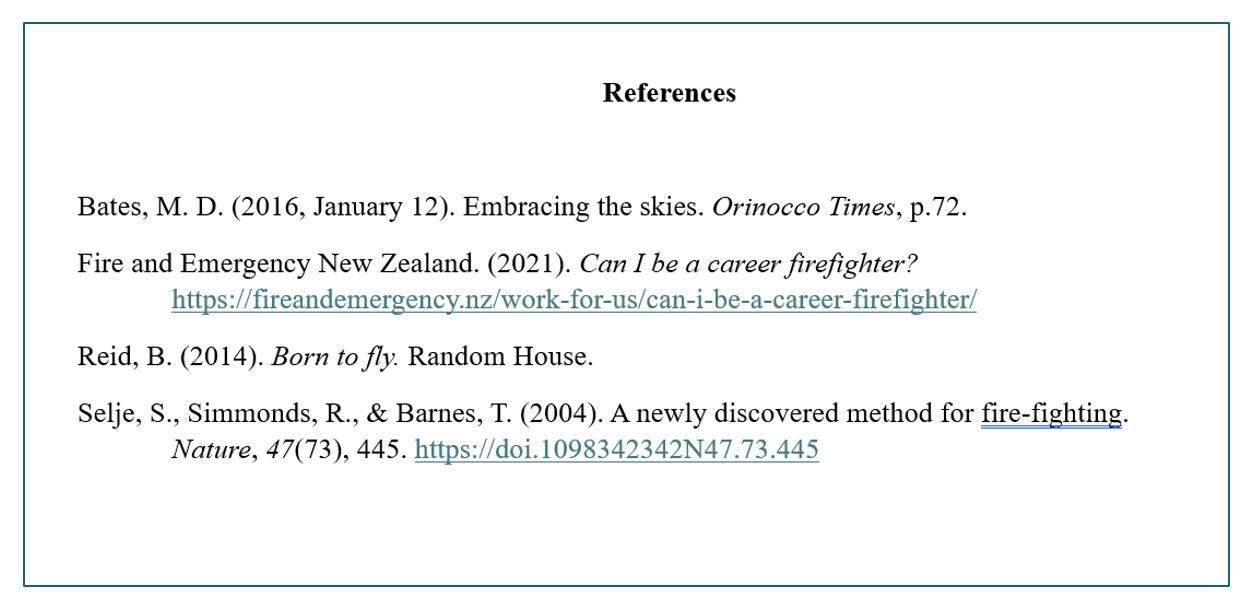
Reference list entries have four key parts:
AUTHOR, DATE, TITLE, SOURCE
(source might be a publisher, journal details, website name, link)
Examples:
Book

Webpage
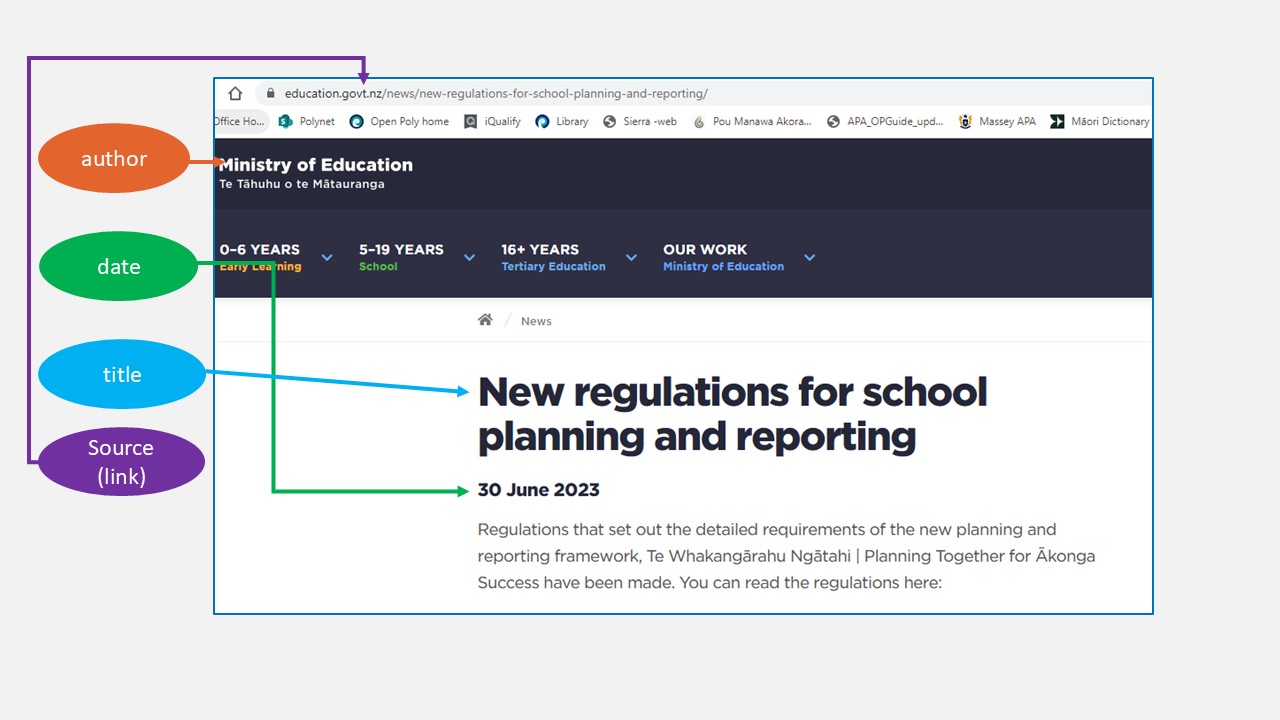

Referencing guides
The above information is a starting point for how to reference.
It is essential you use a referencing guide to learn how to format the reference for each particular type of source you use, e.g. journal article, news item, report, etc.
See Referencing guides.
Further resources
Quick drag n drop exercises - (Worthington et al., 2022)
These are a fun way to test yourself on the correct format for different source types.
Video: Introduction to how to reference in APA 7th ed. style [3.47 mins]
How do I quote or paraphrase?
(Also check out our video below).
|
Note, including information from other sources is only part of writing an assessment. It is important that much of the writing is your own words. Other sources are generally used to:
|
There are two main ways to include information from other sources in your assessments:
- Paraphrasing – when you re-phrase information into your own words, while keeping the essential ideas of the original source.
- Quoting (also called a quotation or direct quote) – when you use the exact words from the original source without making any changes.
Paraphrasing
Paraphrasing is often preferred over quoting in an assessment as it shows your understanding of the ideas of the author.
Tips for paraphrasing:
- make sure you understand the meaning of the text you are paraphrasing
- write the main idea/s in your own words
- it is important to re-write the information completely, rather than simply changing a word or two. This is to show you have understood the information you are using, and to avoid plagiarism. - check what you write against the original to ensure you have the meaning right
- We recommend you watch the video at the end of this page to see an example of how to paraphrase well.
When you paraphrase you must still specify where you got your information. Note the author and year in the example below:
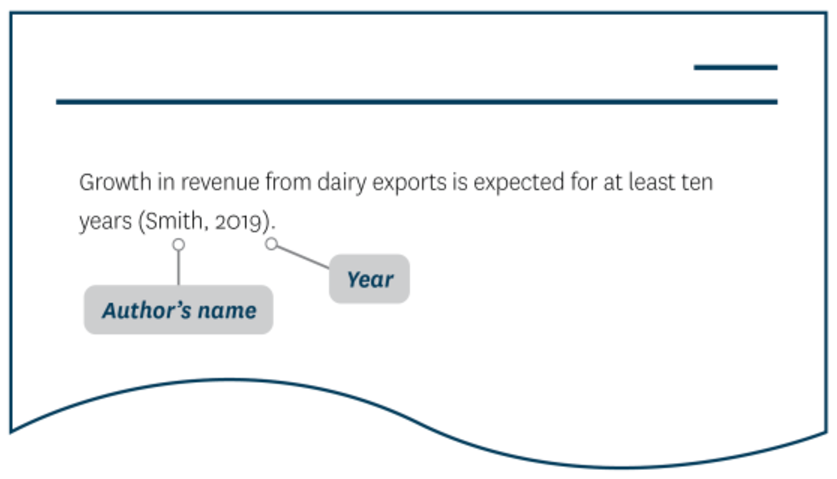
Quoting
Generally, it's best to paraphrase rather than quote.
Quotes are useful for:
- exact definitions
- when you want to show an author’s exact position, or
- when it’s too difficult to paraphrase a short technical statement.
Back up quotes with examples or discussion. Note, your assessment should not be a whole lot of quotes from other sources, and nothing else. This is another form of plagiarism.
There are two types of quotes: long quotes and short quotes. Each has different formatting:
- a short quote should contain fewer than 40 words.
- a long quote, also called a block quote, is for 40 words or more.
Short quote
Short quotes include a page number* and the quoted words are included within double quotation marks. For example:
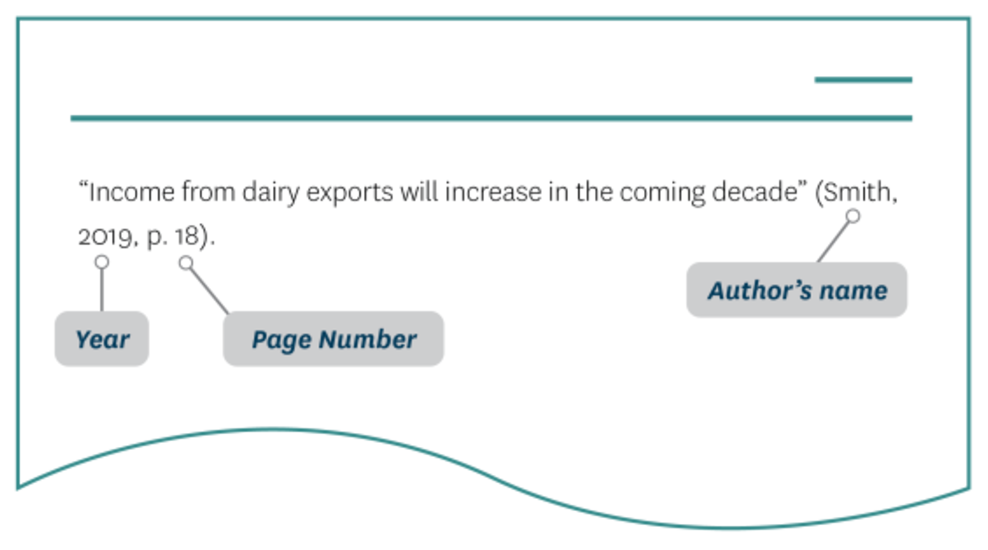
* If there are no page numbers, such as on a webpage, use the paragraph number and/or section heading, e.g. (Smith, 2019, Predictions, para. 4). See our APA Referencing guide to learn more, under How do I cite a publication when quoting?
Long quote
In the example below notice that:
- the quote is not placed in quotation marks; instead it is dropped to the next line and indented
- the page number is included after the quote.
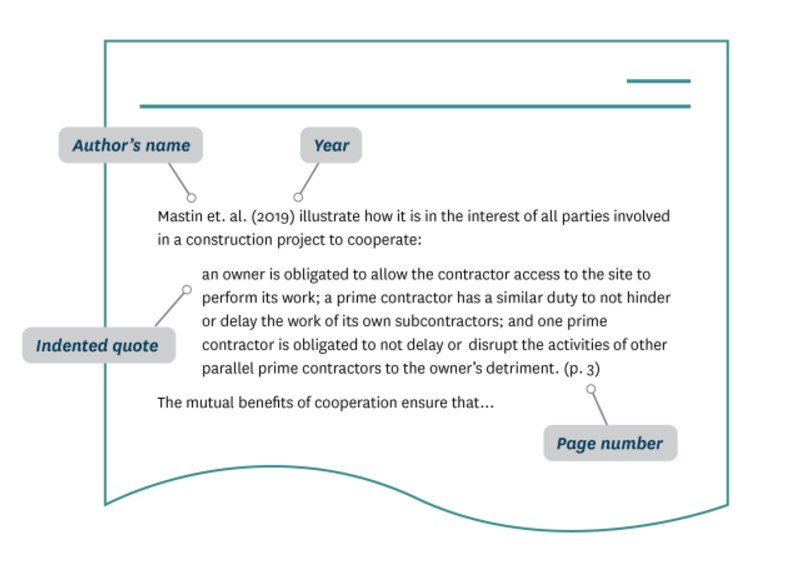
Partial quote
Sometimes, specialised words may be included within a paraphrase, as a partial quote (enclosed in quotation marks). For example:
Vailea (2020) describes how her dancers must have a well refined “spatial awareness” and be able to dance in a wide variety of terrains (p. 35).
Quoting and paraphrasing in action
Watch the video [5.38 mins] below to see examples of how to quote, and how to write a good paraphrase:
Further resources
We recommend you check out the Study Toolkit in iQualify for practice activities in paraphrasing under: Assessments / Get your ideas across / Paraphrasing
Summarising
Summarising is when you write a brief overview of a longer piece of work in your own words. This could be a book, chapter or article.
Writing a summary is a particular type of assessment task (whereas paraphrasing is used in any assessment as part of your referencing).
Summaries are much shorter than the original text, but include the author’s main points. Below is an example of an article summary:
Malcolm, J. (2018). The importance of “maths talk” in early childhood. Young Learners, 9(12). 33-35.
In this article, Jennifer Malcolm discusses the role early childhood carers can play in helping young children develop their mathematical knowledge. She cites several studies which show that regular use of mathematical language by a carer, integrated into the day, provides children with a way to both express and further their own knowledge of mathematical concepts. Along with specific number vocabulary, Malcolm suggests key strategies for carers to use with young children including connection making, discussion, comparison and prediction.
(Note, like quotes and paraphrases, summaries must be attributed to the original author.)
Reporting and linking words
Reporting words and linking or transition words are important techniques to use when adding in-text references to your writing.
Reporting words
Reporting words can show an author’s point of view or position on a topic. Here’s some examples of how you might use a reporting word, when referring to someone else’s work:
- According to Grady et al. (2019), emotions are
- Peart (2018) argues that …
(Note, as the author is mentioned as part of the sentence, they don't need to be repeated within the in-text citation brackets. Simply include the year (and page number if quoting)).
Here is a range of reporting words that you might like to try:
|
|
Linking words
Here are linking words you could try using in your writing:
Sequence:
- Firstly, secondly, thirdly
- In addition
- Furthermore
- Another
- Also
- Finally.
Addition:
- In addition
- Furthermore
- And
- As well as
- Also
- Too.
Example:
- For example
- For instance
- That is to say
- Such as
- Including
- Namely.
Tip – The more you use reporting and linking words, the better you will become at writing.
Referencing guides
Below we have listed our APA referencing guides, along with others we also recommend.
Note, different layouts suit different learning styles. We recommend checking out the guides below and seeing which layout works best for you. Each guide provides standard APA formatting information, but presents it in a different way.
Open Polytechnic guides
- Open Polytechnic APA referencing guide - includes information on referencing course material
- Open Polytechnic APA guide to figures and tables
